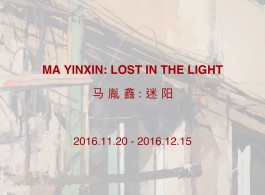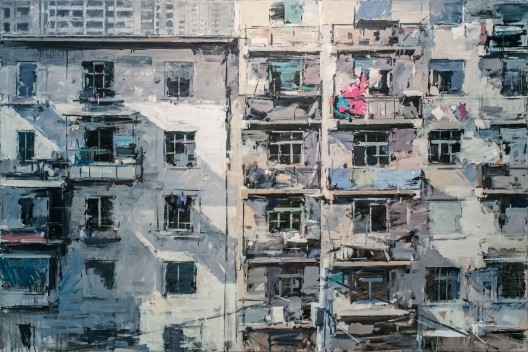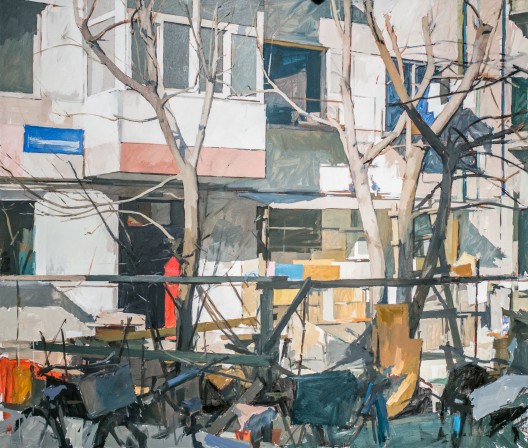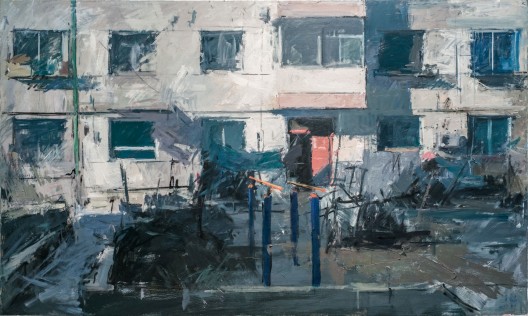Article / YAN Yuting
I was glad that I saw Ma’s works before meeting him in person, because I was able to appreciate his works directly. In fact, I had been trying to clearly explain his works with texts, but any kind of explanation, including conceptual definition, stylized description, or sociological analysis, is in conflict with the works’ self-existences. However, I was unable to find the linear logics of his works from a cultural identification or an aesthetic theory. The works appear to be in an independent state that extends to me conversely, and the state evokes my diffuse thinkings.
In 2006, Ma YinXin started painting buildings from the 90s in ShenYang, China. For the following decade, he has been working on the same theme. Some people asked, “Why do you keep painting old architectures?”, and I had a similar confusion the first time seeing his works. Gradually, I realized that my original thinking was unable to find the point of coherence. Therefore, I started thinking about the opposite question, “Why not keep painting architectures?” In my opinion, the theme and content of figurative paintings are more to be used as the supports of narratives and emotional expression, but the theme and content of Ma’s painting are exceptionally rational. Ma said, “These architectures were very common in Shen Yang back in 2006, and people didn’t developed too much of nostalgia over the meanings and the representations. But, as the city became more developed and urbanized, these old buildings were no longer existed. People suddenly are nostalgic about the lost.” Ma YinXin’s paintings are not made out of a sociological system, and the repetitive theme also shows his indifference towards extensive signification and symbolication. This method creates a canonical form and becomes the artist’s methodology of moving from a changeable exterior of the world into a painterly interior.
MA Yinxin passes through a method of self-limitation, interlocks the dimension of creativity within a narrow space, and with the method of limitation, controls the expansion of this space. In this space, viewers can discover the connection between ultimate imageries and initial materials. Composition comes primarily. Use first-handed photographic composition and then edit contrastive imageries to establish painterly composition, MA YinXin has gone through a few transitional experiments: from classic Baroque composition to Mondrian grid composition. In this transition, the considerations of the marginality of painting and depiction of angels have direct effects on imagery constitution and graphic performances. Painting, a fairly traditional thinking method, pushes the possibility of composition to a more defined and more accurate level. Once the composition is established, we soon realize that the painterly brushworks, on the one hand, passes through a linear logic to create connections with the composition, and on the other hand, passes through colors and brushworks then pushes the image to a second-handed reality of self-existence. Regarding the expression of lighting, the artist uses the establishment of representation, while creating another objectified reality. The overall image, because of Ma’s self-painterly method of intervening lighting in original images, pushes the meticulous details into the section between reality and non-reality.
The title LOST IN THE LIGHT has the meaning of dying in bright light. Interchanging between the concepts of light and shadow, the artist uses the painterly lighting to pour a subtle emotional expression into the armored concrete of architectures.This way of expressing is implicit, and it integrates the materializations of the painting materials into the materialization of architecture between an objectified reality and painting, which establishes a painterly architecture that reveals the importance of pictorial materializations. Speaking from this meaning, if limitation is an unavoidable condition, then within the limitation, the question of how to reveal the deep logic and the artist’s individual right of expression becomes an autologous vitality that lives in a narrow crack. By living in the ambiguity of concepts, it forms a painterly language.
If we have to discuss the meaning of concepts, MA’s concepts are independent from the works. Based on the completion of the works, MA evokes the adjustment to the external world. Using “non-change” as a social consideration, MA uses the changeable settings in the society to establish connections with the works’ time, speak, social representation and adjustment of expressive content.
It seems to be easier for us to comprehend the meanings of these changes and revolutions. This coordination has become the best frames for the interpretation of explaining the external world. But the analysis of the concepts don’t grow within the works; they are established after the completion. Speaking from this perspective, MA’s works don’t change because of the externality but on an internal self-validation that’s based on the adjustment and deduction within painting.
The name MI YANG comes from Zhuang Zhou’s The Land of Living. Mi Yang means a plant that’s full of thorns. Maybe in this multi-culture era, MA’ choice of painting is going through a seemingly-safe rode that’s full of thorns. Because of his consistence and deduction in painting, his works interrupt the realistic objects and painterly language, and they establish a painterly-like process that’s not noticeable.






